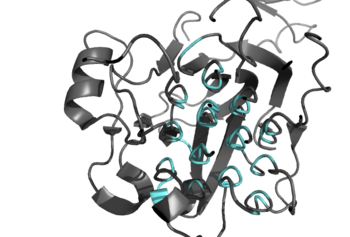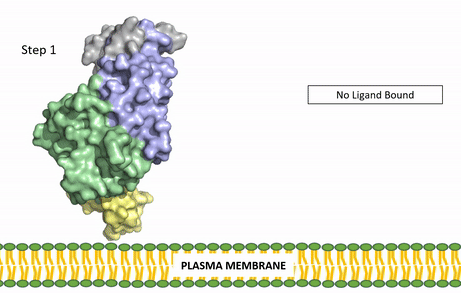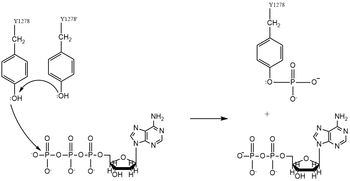Sandbox Reserved 1705
From Proteopedia
(Difference between revisions)
| Line 6: | Line 6: | ||
== Introduction == | == Introduction == | ||
[[Image:ALK_Domains.png|350 px|right|thumb|Figure 1. Outline of the domains and regions of anaplastic lymphoma kinase]] | [[Image:ALK_Domains.png|350 px|right|thumb|Figure 1. Outline of the domains and regions of anaplastic lymphoma kinase]] | ||
| - | Anaplastic lymphoma kinase is a [https://en.wikipedia.org/wiki/Receptor_tyrosine_kinase receptor tyrosine kinase] (RTK) important to the regulation of functions within the central nervous system <ref name="Reshetnyak">PMID:34819673</ref>. RTKs are the high-affinity cell surface receptors for many polypeptide growth factors, cytokines, and hormones. ALK activates pathways that promote cell growth and proliferation, similar to the [[Insulin Receptor|Insulin Receptor (IR)]]. These pathways include, but are not limited to, the [https://en.wikipedia.org/wiki/MAPK/ERK_pathway ERK], [https://en.wikipedia.org/wiki/JAK-STAT_signaling_pathway JAK], and [https://en.wikipedia.org/wiki/PI3K/AKT/mTOR_pathway PI3K] pathways. ALK is composed of two identical monomers consisting of seven unique domains, and two intermixed regions. Among these, | + | Anaplastic lymphoma kinase is a [https://en.wikipedia.org/wiki/Receptor_tyrosine_kinase receptor tyrosine kinase] (RTK) important to the regulation of functions within the central nervous system <ref name="Reshetnyak">PMID:34819673</ref>. RTKs are the high-affinity cell surface receptors for many polypeptide growth factors, cytokines, and hormones. ALK activates pathways that promote cell growth and proliferation, similar to the [[Insulin Receptor|Insulin Receptor (IR)]]. These pathways include, but are not limited to, the [https://en.wikipedia.org/wiki/MAPK/ERK_pathway ERK], [https://en.wikipedia.org/wiki/JAK-STAT_signaling_pathway JAK], and [https://en.wikipedia.org/wiki/PI3K/AKT/mTOR_pathway PI3K] pathways. ALK is composed of two identical monomers consisting of seven unique domains, and two intermixed regions. Among these, one of the most notable is the glycine-rich region (GlyR), characterized by helical structures formed by glycine residues. Other domains are archetypal of RTK activation and regulation. Several potential human ALK ligands have been discovered, however two ALK activating ligands (ALKALs) have been further studied for their ability to activate ALK, ALK homologs, and ALK fusion proteins <ref name="Huang">PMID: 30400214</ref>. The preferred ALKAL for activation of the kinase domain is AUG, which binds in a dimeric fashion to ALK, inducing a conformational change. In order to determine the atomic details of human ALK dimerization and activation by AUG, the methods of [https://en.wikipedia.org/wiki/Cryogenic_electron_microscopy cryo-electron microscopy], [https://en.wikipedia.org/wiki/Nuclear_magnetic_resonance_spectroscopy nuclear magnetic resonance], and [https://en.wikipedia.org/wiki/X-ray_crystallography X-ray crystallography] were utilized <ref name="Reshetnyak">PMID:34819673</ref>. Due to its role in cell growth and proliferation signaling, ALK is considered to be a proto-oncogene, meaning that it is capable of producing mutations that lead to cancer. ALK mutations can lead to various types of cancers, including non-small-cell lung cancer, anaplastic large cell lymphoma, squamous cell carcinoma, and inflammatory myofibroblastic cancer <ref name="Palmer">PMID:19459784</ref>. |
| Line 12: | Line 12: | ||
== General Structure == | == General Structure == | ||
[[Image:Ray_Traced_GlyR_Image.png|350 px|left|thumb|Figure 2: Shown in teal is the Glycine Rich Region of ALK in its helical structure. ]] | [[Image:Ray_Traced_GlyR_Image.png|350 px|left|thumb|Figure 2: Shown in teal is the Glycine Rich Region of ALK in its helical structure. ]] | ||
| - | Anaplastic lymphoma kinase is a <scene name='90/904310/Dimer/5'>homodimer</scene>, in which each <scene name='90/904310/Monomer_a/3'>monomer</scene> contains seven domains and two regions <ref name="Tongqing">PMID:34819665</ref>. These domains and regions are as follows: N-terminal region (NTR), two meprin–A-5 protein–receptor protein tyrosine phosphatase μ domains (MAM), low density lipoprotein receptor class A domain (LDL), <scene name='90/904310/Tnf_highlighted_monomer/5'>tumor necrosis factor receptor-like domain</scene> (TNF), <scene name='90/904310/Glyr_highlighted_monomer/5'>glycine rich region</scene> (GlyR), <scene name='90/904310/Egf_highlighted_monomer/3'>epidermal growth factor receptor-like domain</scene> (EGF), transmembrane α-helix (TMH), kinase domain <ref name="Reshetnyak">PMID:34819673</ref>. The NTR functions as a signal peptide, the structure of which is yet to be determined. Both MAM domains and the LDL domain are unique to ALK within the superfamily of RTKs, and the biological role of these domains has not yet been determined <ref name="Huang">PMID: 30400214</ref>. However, the LDL and MAM regions are thought to be involved in various regulatory functions; studies of other LDL protein domains indicate a role for LDL domains in plasma cholesterol homeostasis <ref name="Pedersen">PMID:24798328</ref>. Additionally, research on MAM domains implicates a role in cell-cell interactions through homophilic binding <ref name="Huang">PMID: 30400214</ref>. The TNF-like domain assists in mediating mature T-cell receptor induced apoptosis. Both the TNF domain and GlyR region are discontinuous, traversing each other frequently <ref name="Reshetnyak">PMID:34819673</ref>. The GlyR region consists of | + | Anaplastic lymphoma kinase is a <scene name='90/904310/Dimer/5'>homodimer</scene>, in which each <scene name='90/904310/Monomer_a/3'>monomer</scene> contains seven domains and two regions <ref name="Tongqing">PMID:34819665</ref>. These domains and regions are as follows: N-terminal region (NTR), two meprin–A-5 protein–receptor protein tyrosine phosphatase μ domains (MAM), low density lipoprotein receptor class A domain (LDL), <scene name='90/904310/Tnf_highlighted_monomer/5'>tumor necrosis factor receptor-like domain</scene> (TNF), <scene name='90/904310/Glyr_highlighted_monomer/5'>glycine rich region</scene> (GlyR), <scene name='90/904310/Egf_highlighted_monomer/3'>epidermal growth factor receptor-like domain</scene> (EGF), transmembrane α-helix (TMH), kinase domain <ref name="Reshetnyak">PMID:34819673</ref>. The NTR functions as a signal peptide, the structure of which is yet to be determined. Both MAM domains and the LDL domain are unique to ALK within the superfamily of RTKs, and the biological role of these domains has not yet been determined <ref name="Huang">PMID: 30400214</ref>. However, the LDL and MAM regions are thought to be involved in various regulatory functions; studies of other LDL protein domains indicate a role for LDL domains in plasma cholesterol homeostasis <ref name="Pedersen">PMID:24798328</ref>. Additionally, research on MAM domains implicates a role in cell-cell interactions through homophilic binding <ref name="Huang">PMID: 30400214</ref>. The TNF-like domain assists in mediating mature T-cell receptor induced apoptosis. Both the TNF domain and GlyR region are discontinuous, traversing each other frequently <ref name="Reshetnyak">PMID:34819673</ref>. The GlyR region consists of several glycine helices, a highly unique structure. Though the function of ALK's EGF domain is unknown, EGF domains are typically found in the extracellular region and are thought to be important building blocks for extracellular proteins <ref name="Selander-Sunnerhagen">PMID:1527084</ref>. The TMH connects the extracellular and intracellular regions of ALK through the plasma membrane. The kinase domain is in the intracellular region and is autoactivated through phosphorylation at positions <scene name='90/904309/Tyrosines/1'>Y1278, Y1282, and Y1283</scene>. This allows the RTK to begin signaling cascades throughout the cell <ref name="Selander-Sunnerhagen">PMID:1527084</ref>. While the structures of the N-terminal region, MAM, and LDL have not been determined, it has been shown that only the TNF, GlyR, and EGF portions of ALK are required in the extracellular region for ligand activation via ALKALs <ref name="Palmer">PMID: 19459784</ref>. All portions of anaplastic lymphoma kinase are located in the extracellular domain except for the transmembrane α-helix, which is in the transmembrane region, and the kinase domain located in the intracellular region. |
Revision as of 18:01, 18 April 2022
| This Sandbox is Reserved from February 28 through September 1, 2022 for use in the course CH462 Biochemistry II taught by R. Jeremy Johnson at the Butler University, Indianapolis, USA. This reservation includes Sandbox Reserved 1700 through Sandbox Reserved 1729. |
To get started:
More help: Help:Editing |
| |||||||||||
References
- ↑ 1.0 1.1 1.2 1.3 Reshetnyak AV, Rossi P, Myasnikov AG, Sowaileh M, Mohanty J, Nourse A, Miller DJ, Lax I, Schlessinger J, Kalodimos CG. Mechanism for the activation of the anaplastic lymphoma kinase receptor. Nature. 2021 Dec;600(7887):153-157. doi: 10.1038/s41586-021-04140-8. Epub 2021, Nov 24. PMID:34819673 doi:http://dx.doi.org/10.1038/s41586-021-04140-8
- ↑ 2.0 2.1 2.2 Huang H. Anaplastic Lymphoma Kinase (ALK) Receptor Tyrosine Kinase: A Catalytic Receptor with Many Faces. Int J Mol Sci. 2018 Nov 2;19(11). pii: ijms19113448. doi: 10.3390/ijms19113448. PMID:30400214 doi:http://dx.doi.org/10.3390/ijms19113448
- ↑ 3.0 3.1 Palmer RH, Vernersson E, Grabbe C, Hallberg B. Anaplastic lymphoma kinase: signalling in development and disease. Biochem J. 2009 May 27;420(3):345-61. doi: 10.1042/BJ20090387. PMID:19459784 doi:http://dx.doi.org/10.1042/BJ20090387
- ↑ Li T, Stayrook SE, Tsutsui Y, Zhang J, Wang Y, Li H, Proffitt A, Krimmer SG, Ahmed M, Belliveau O, Walker IX, Mudumbi KC, Suzuki Y, Lax I, Alvarado D, Lemmon MA, Schlessinger J, Klein DE. Structural basis for ligand reception by anaplastic lymphoma kinase. Nature. 2021 Dec;600(7887):148-152. doi: 10.1038/s41586-021-04141-7. Epub 2021, Nov 24. PMID:34819665 doi:http://dx.doi.org/10.1038/s41586-021-04141-7
- ↑ Pedersen NB, Wang S, Narimatsu Y, Yang Z, Halim A, Schjoldager KT, Madsen TD, Seidah NG, Bennett EP, Levery SB, Clausen H. Low density lipoprotein receptor class A repeats are O-glycosylated in linker regions. J Biol Chem. 2014 Jun 20;289(25):17312-24. doi: 10.1074/jbc.M113.545053. Epub, 2014 May 5. PMID:24798328 doi:http://dx.doi.org/10.1074/jbc.M113.545053
- ↑ 6.0 6.1 Selander-Sunnerhagen M, Ullner M, Persson E, Teleman O, Stenflo J, Drakenberg T. How an epidermal growth factor (EGF)-like domain binds calcium. High resolution NMR structure of the calcium form of the NH2-terminal EGF-like domain in coagulation factor X. J Biol Chem. 1992 Sep 25;267(27):19642-9. PMID:1527084
- ↑ 7.0 7.1 Li T, Stayrook SE, Tsutsui Y, Zhang J, Wang Y, Li H, Proffitt A, Krimmer SG, Ahmed M, Belliveau O, Walker IX, Mudumbi KC, Suzuki Y, Lax I, Alvarado D, Lemmon MA, Schlessinger J, Klein DE. Structural basis for ligand reception by anaplastic lymphoma kinase. Nature. 2021 Dec;600(7887):148-152. doi: 10.1038/s41586-021-04141-7. Epub 2021, Nov 24. PMID:34819665 doi:http://dx.doi.org/10.1038/s41586-021-04141-7
- ↑ 8.0 8.1 De Munck S, Provost M, Kurikawa M, Omori I, Mukohyama J, Felix J, Bloch Y, Abdel-Wahab O, Bazan JF, Yoshimi A, Savvides SN. Structural basis of cytokine-mediated activation of ALK family receptors. Nature. 2021 Oct 13. pii: 10.1038/s41586-021-03959-5. doi:, 10.1038/s41586-021-03959-5. PMID:34646012 doi:http://dx.doi.org/10.1038/s41586-021-03959-5
- ↑ Hallberg B, Palmer RH. Mechanistic insight into ALK receptor tyrosine kinase in human cancer biology. Nat Rev Cancer. 2013 Oct;13(10):685-700. doi: 10.1038/nrc3580. PMID:24060861 doi:http://dx.doi.org/10.1038/nrc3580
- ↑ Lewis RT, Bode CM, Choquette D, Potashman M, Romero K, Stellwagen JC, Teffera Y, Moore E, Whittington DA, Chen H, Epstein LF, Emkey R, Andrews PS, Yu V, Saffran DC, Xu M, Drew AE, Merkel P, Szilvassy S, Brake RL. The discovery and optimization of a novel class of potent, selective and orally bioavailable Anaplastic Lymphoma Kinase (ALK) Inhibitors with potential utility for the treatment of cancer. J Med Chem. 2012 Jun 26. PMID:22734674 doi:10.1021/jm3005866
- ↑ 11.0 11.1 Sahu A, Prabhash K, Noronha V, Joshi A, Desai S. Crizotinib: A comprehensive review. South Asian J Cancer. 2013 Apr;2(2):91-7. doi: 10.4103/2278-330X.110506. PMID:24455567 doi:http://dx.doi.org/10.4103/2278-330X.110506
- ↑ 12.0 12.1 Wang Q, Zorn JA, Kuriyan J. A structural atlas of kinases inhibited by clinically approved drugs. Methods Enzymol. 2014;548:23-67. doi: 10.1016/B978-0-12-397918-6.00002-1. PMID:25399641 doi:http://dx.doi.org/10.1016/B978-0-12-397918-6.00002-1
PDB Files Used
Student Contributors
- Kaylin Todor
- Rebekah White





